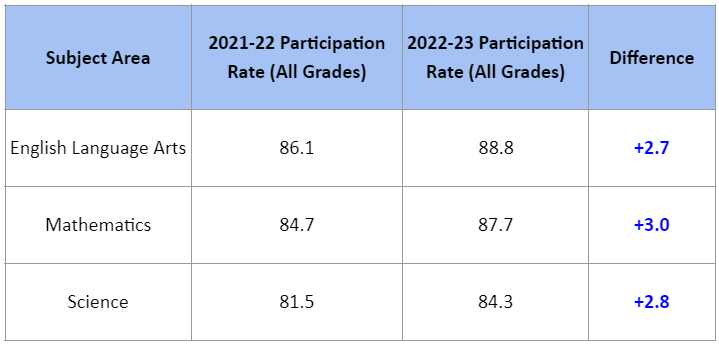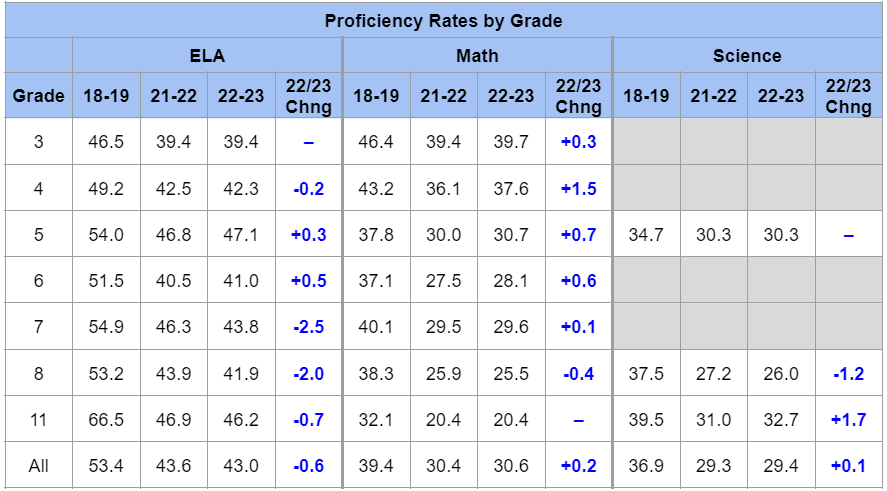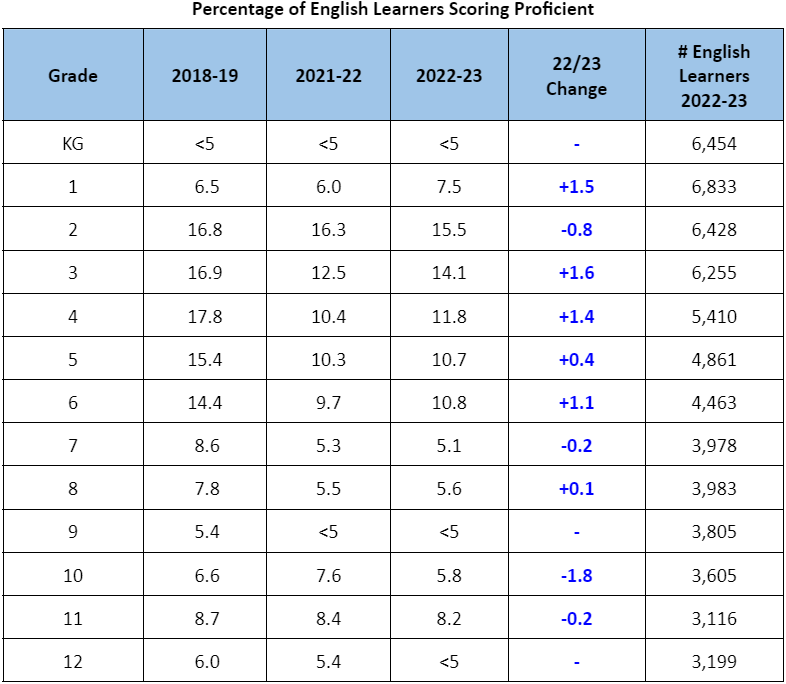|
NEWS RELEASE
September 21, 2023
Media Contact: Marc Siegel
2023 Oregon Statewide Assessment System
Results Show More Students Participating, Improvements in Some Areas
This year’s state summative test results show that our education system is stabilizing. Some student groups have achieved pre-pandemic levels in English language arts, mathematics, and science in Oregon districts. There is still great need and continued investment is needed to support and accelerate learning.
Substantial investments like the Student Success Act, the High School Success program, the Early Literacy Success Initiative, equitable expenditure of the State School Fund, and federal investments in high-quality instruction and other strategies that support academic acceleration, student mental health, and other needs should accelerate academic growth in the coming years.
(Salem, OR) – The Oregon Department of Education (ODE) today released results from the Oregon Statewide Assessment System’s spring 2023 summative tests. These results, when compared to results prior to the pandemic, show the impact of the pandemic and demonstrate the need for continued investment in accelerating learning in summer and after school programs through school and community-based organizations, the Early Literacy Success Initiative, the Student Success Act, the High School Success Act, and other programs targeting the needs of students.
More students participated in Oregon’s summative tests compared to the previous year. When more students participate, the confidence in the results increases. While still below levels from before the global COVID-19 pandemic, it’s a positive step.
 “We need to maintain high expectations and provide high levels of support that will lead to academic excellence for all of our students, whether it’s making sure each and every child from birth through 5th grade is set up for success in learning to read and reading to learn or providing opportunities for high school students to find their path to their dream career,” ODE Interim Director Dr. Charlene Williams said. “We know that staff and students work hard throughout the school year in so many areas that aren't reflected in this assessment data. The results from a single test do not tell the whole story of education in Oregon, however they are important indicators that require our attention and more work ahead.”
“Students have shown resilience in navigating the ups and downs of learning in the pandemic,” Governor Tina Kotek said. “These latest scores affirm the need to target state investments in our education system, including community-based summer and afterschool programs to accelerate learning and strengthen student wellbeing. These scores show we’re stabilizing, but we can accelerate learning with more out-of-school time investments.”
Purpose of Summative Content Tests
State summative content tests are designed to identify differences in student group outcomes and help improve the education system over time. These tests do not measure the breadth of academic learning of any individual student. They are robust measures, but are limited to three academic subject areas. They do not name all the strengths, talents, gifts, or needs of any individual. And, they do not describe the full context of what a school is providing socially or academically to students.
Statewide summative test results provide one important measure of school performance and progress annually. These results are easily accessed and quantified and receive attention, in part, because they are easily communicated. Our schools also provide hot meals to nourish our children; warm hugs and high expectations from caring educators; counseling and support; access to support for students who find themselves houseless; hands-on career training and experiences; college credits at little or no cost; and clubs, sports, and activities that offer connection and relevance for students. There is so much we are not able to measure on a state scale and all of it impacts our childrens’ success.
That said, the results hold value by informing education planning and decision making in critical ways. The information from summative tests helps evaluate academic programs across districts and schools and boost school districts’ ability to prioritize additional funds, resources, and supports to the schools, educators, and students who need them most.
State summative test results are most useful when participation thresholds are met. Similar to the challenge of trying to clearly see a pixelated image that lacks individual pixels, it’s harder to see the picture of the education system when participation is lacking. That is why participation in the state summative tests is central to helping improve outcomes for all of Oregon’s students.
Test data should be used constructively—to help inform parents and families about their students’ schools and to ensure schools receive the necessary resources to help support students. Test interpretations should focus on identifying strengths and accelerating student growth, not enacting deficit frames for Oregon’s schools.
A Balanced Assessment System
Oregon’s state assessment system is balanced. It includes coherent, comprehensive, and continuous resources, including: formative assessment resources, interim tests, and summative tests. The resources and data available to all of Oregon’s districts can be used to accelerate learning at all times for students: in the moment in the classroom, periodically throughout the school year, and from year-to-year.
In addition, ODE is shifting toward incorporating qualitative sources of information to support a well-rounded understanding of system strengths and growth areas. Two examples of this shift include the Student Education Equity Development (SEED) Survey, which will now be made available to all students grades 3-11, and the Early Learning Transition Check-in (ELTC) Family Conversation, which is entering its second year of a pilot in multiple school districts throughout the state. The SEED Survey invites students to share their feedback on their opportunity to learn, self-efficacy, access to learning resources, and sense of belonging, which helps to better develop insights about how students experience different parts of the system that the statewide summative assessments are measuring. Additionally, the ELTC Family Conversation helps to provide part of a baseline to learn what families are hoping the education system will do for their children. Combining these data points will work towards creating a more holistic picture that goes far beyond only what is seen in a test score.
ELA, Math, and Science Summative Test Results
This year’s results show that our education system is stabilizing. These results also demonstrate that the impacts of the pandemic are lasting. Some student groups have achieved pre-pandemic levels in English language arts, mathematics, and science in Oregon districts, but Oregon students need continued investment and time to grow toward grade level proficiency.
The results are a snapshot in time and reflect how student groups performed in three content areas: English language arts (ELA), mathematics and science. The ELA and mathematics summative tests are given in grades 3-8 plus 11th grade; science assessments are given in grades 5, 8 and 11. The table below shows the percentage of students who were proficient in Spring 2023. The term “proficient” refers to the achievement level that students achieve and whether they are on track to be college and career ready once they graduate from high school. Students are considered proficient if they are at Level 3 or Level 4 on the English language arts (ELA), mathematics, or science tests.
 The high school results here remain below our Technical Advisory Committee-recommended confidence threshold of 80% participation. They should therefore not be compared across schools or districts, nor with prior year results, unless those local areas had substantial participation rates in the time periods referenced.
English Language Proficiency Assessment Results
Oregon’s English Language Proficiency Assessments (ELPA) evaluate reading, writing, listening, and speaking for students who are multilingual learners. Students who demonstrate proficiency are no longer eligible for English language development services, as they are able to access grade level content that is being provided in English. Oregon’s ELPA results are provided below.
 Oregon’s statewide investments must support all students, but specifically focus resources on students who have experienced the most disruption in their education and have the fewest opportunities for success. The impact of the global pandemic is still present in our education system, including our educator workforce. We must also invest to better support teachers, support staff, and school leaders, including by bringing more diverse, highly qualified, and caring adults into the education profession.
# # #
|